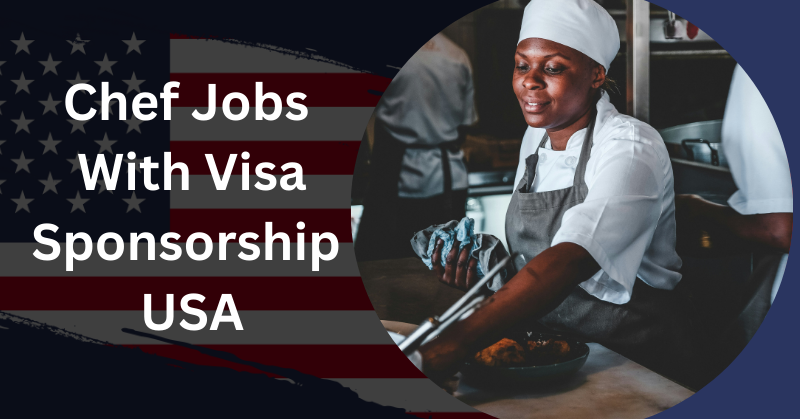The United States presents a compelling destination for international chefs, drawn by its vibrant and multifaceted culinary landscape.
This guide offers a detailed exploration of the pathways available for skilled culinary professionals from around the world to secure employment with visa sponsorship in the USA.
It delves into the current demand for chefs, the diverse roles within the industry, the intricacies of US work visas, effective job search strategies, potential employers, salary expectations, and essential steps for a successful transition.
Setting the Stage for International Chef Jobs in the USA
The American culinary scene is a rich tapestry woven from global influences, constantly evolving and offering a platform for innovation and creativity. From bustling urban centers to serene countryside towns, the demand for culinary expertise is pervasive, making the USA an attractive destination for chefs seeking to expand their horizons.
The nation’s appetite for diverse flavors and dining experiences continues to grow, creating a welcoming environment for international chefs to contribute their unique skills and perspectives. This openness to global culinary trends signifies a favorable setting for chefs from various cultural backgrounds to not only practice their craft but also to enrich the American gastronomic landscape.
Benefits of Chef Jobs With Visa Sponsorship USA – Work in USA
Pursuing a culinary career in the USA with visa sponsorship offers numerous potential benefits for international chefs.
The US culinary scene provides ample opportunities for career advancement and professional growth. Exposure to new culinary trends, innovative techniques, and diverse ingredients in a dynamic and competitive market allows chefs to continuously expand their skills and knowledge . Working alongside talented American and international chefs can lead to invaluable learning experiences and career progression within a variety of culinary establishments.
The multicultural nature of American cuisine offers a unique opportunity for cultural exchange. International chefs have the chance to not only learn about and incorporate various culinary traditions but also to share their own culinary heritage with the American palate . This exposure to diverse flavors and cooking styles can be both personally enriching and professionally rewarding.
While salaries can vary, the US hospitality industry offers the potential for earning competitive salaries and accessing benefits, particularly for skilled and experienced chefs in higher-end establishments and major metropolitan areas . The financial rewards, coupled with the opportunities for professional development and cultural immersion, make the USA an attractive destination for international chefs seeking to build a fulfilling and successful career.
Types of Chef Jobs in the USA
The culinary landscape in the United States is diverse and dynamic, offering a wide array of chef positions. Each role carries unique responsibilities and requires specific skill sets. For those seeking visa sponsorship, understanding these distinctions is crucial.
-
Executive Chef: The Executive Chef is the head of the kitchen, responsible for menu planning, staff management, and overall kitchen operations. This role demands extensive experience, strong leadership skills, and a proven track record of culinary excellence. Executive Chefs often work in high-end restaurants, hotels, or large catering companies and are involved in budgeting and purchasing.
-
Sous Chef: Serving as the second-in-command, the Sous Chef assists the Executive Chef and oversees daily kitchen operations. They are responsible for training staff, ensuring food quality, and managing inventory. This role requires strong organizational skills and the ability to work under pressure, often stepping in for the Executive Chef when needed.
-
Chef de Partie (Station Chef): Specializing in a specific area of the kitchen, such as sauces, pastries, or grilling, the Chef de Partie manages a particular station. They ensure consistent quality and presentation of dishes from their assigned area. This position requires in-depth knowledge of specific culinary techniques and the ability to work efficiently within a team.
-
Pastry Chef: Focusing on desserts, pastries, and baked goods, the Pastry Chef creates and prepares sweet dishes. They must have a strong understanding of baking techniques, pastry art, and dessert presentation. This role is essential in restaurants, bakeries, and hotels, and requires both creativity and precision.
-
Line Cook: Working on the cooking line during service, Line Cooks prepare and plate dishes according to the chef’s specifications. They must be able to work quickly and efficiently in a fast-paced environment and follow recipes accurately. This is often an entry-level position that provides valuable experience for aspiring chefs.
-
Banquet Chef: Specializing in large-scale food preparation for events, the Banquet Chef manages the production of meals for banquets, conferences, and weddings. They need strong organizational and time-management skills to ensure timely and efficient service for large groups. This role requires the ability to adapt to varying menus and guest counts.
-
Personal Chef: Providing customized meal preparation for private clients, Personal Chefs create menus based on dietary needs and preferences. They often work in private residences or for high-profile individuals. This role demands strong communication skills and the ability to create varied and tailored dining experiences.
-
Catering Chef: Catering Chefs, are responsible for preparing and transporting food for off-site events. They must be able to plan and execute menus for a variety of gatherings, and have strong logistical skills. This role requires the ability to maintain food safety standards during transport and setup.
Visa Options for Chef Jobs With Visa Sponsorship USA
Several US work visa options may be relevant for international chefs seeking employment in the USA. Each visa category has specific eligibility criteria and application processes.
H-2B visa (temporary or seasonal non-agricultural work)
This visa could be a viable option for chefs seeking positions in establishments with seasonal demands, such as resorts in tourist destinations or restaurants during peak seasons . To qualify, the employer must demonstrate a temporary need for the chef’s services and prove that there are no sufficient qualified US workers available for the position without negatively impacting the wages and working conditions of US workers. The chef must be a resident of an eligible country and possess a valid job offer and the required skills for the position. The duration of an H-2B visa can initially be up to 9 months, with the possibility of extensions for a total stay of up to three years for seasonal jobs . This visa pathway is particularly relevant for chefs open to short-term or recurring seasonal employment opportunities in the US hospitality sector. However, it is crucial to recognize that the employer must initiate the labor certification process, making it essential for chefs to identify employers willing to undertake this step.
EB-3 visa (Employment-based Permanent Residency)
For chefs seeking a pathway to permanent residency in the USA, the EB-3 visa is a potential option . This visa category is for skilled workers, professionals, and other workers with a permanent, full-time job offer. The Skilled Workers subcategory requires at least two years of training or experience, which many experienced chefs would likely meet . The process involves the employer obtaining a permanent labor certification from the Department of Labor, demonstrating that no qualified US workers are available for the position . While the EB-3 visa offers the significant benefit of permanent residency, the application process is typically more lengthy and complex compared to temporary visas. It necessitates a substantial commitment from both the chef and the sponsoring employer to navigate the labor certification and subsequent immigration petition processes.
J-1 visa (Training and Visitor Exchange Program)
The J-1 visa is specifically designed for training and cultural exchange programs within the hospitality industry, making it a valuable option for culinary trainees and interns . This visa requires sponsorship through an approved program provider that partners with US employers to offer job placements . Eligibility for the J-1 visa varies depending on whether the applicant is an intern (currently enrolled student or recent graduate) or a trainee (holding a degree and one year of related experience, or possessing five years of work experience in the field) . J-1 programs in hospitality and tourism typically last up to 12 months, although longer durations (up to 18 months) may be possible for hospitality management training . This visa serves as an excellent entry point for younger chefs or those looking to gain international experience in American kitchens and potentially establish connections for future permanent opportunities. Securing a J-1 visa involves applying through designated sponsoring organizations that facilitate placements with US employers.
H-1B visa (Specialty Occupation Visa)
The H-1B visa is for specialty occupations that require a bachelor’s degree or its equivalent in a specific field . Historically, the US Citizenship and Immigration Services (USCIS) has been cautious in classifying chef roles as specialty occupations under this category, unless the position entails significant managerial responsibilities and necessitates a theoretical and practical application of highly specialized knowledge, typically acquired through a bachelor’s degree in culinary arts or hospitality management . To qualify, the employer must demonstrate that the position requires such specialized knowledge and that the chef possesses the equivalent of a US bachelor’s degree in the relevant field through education, training, or a combination of experience and recognized expertise . Therefore, while possible, obtaining an H-1B visa as a chef is generally more challenging and typically limited to senior-level positions with substantial managerial duties and a clear requirement for a degree-level qualification.
For chefs who have achieved extraordinary ability and recognition in their culinary field at a national or international level, the O-1 visa presents an option . This visa requires extensive evidence of sustained acclaim and distinction, such as prestigious culinary awards (e.g., Michelin stars, James Beard awards), significant media coverage in major culinary publications, and leading roles in renowned restaurants . Applicants must typically meet at least three out of several criteria established by immigration authorities to demonstrate their extraordinary ability. The O-1 visa is a prestigious category reserved for chefs who are at the very pinnacle of their profession and can provide substantial documentation to support their exceptional achievements.
E-2 visa
offers a pathway for chefs who are nationals of countries that have a treaty of commerce and navigation with the USA and who make a substantial investment in a US culinary business . This visa is for individuals who will actively manage and direct the business. While there is no fixed minimum investment amount, it must be significant enough to ensure the business’s financial viability and generate more than just a minimal living for the investor and their family . Establishing a full-service restaurant often involves substantial upfront costs that can meet this requirement . A well-structured business plan is essential to demonstrate the viability and economic impact of the proposed culinary venture . The E-2 visa provides an opportunity for entrepreneurial chefs from treaty countries to establish their culinary careers in the USA through business ownership.
Requirements and Eligibility for Chef Jobs With Visa Sponsorship USA
Securing a chef job with visa sponsorship in the United States requires meeting specific requirements and eligibility criteria. Understanding these prerequisites is essential for navigating the application process successfully.
- Formal Culinary Educational Qualifications: Formal culinary education from a recognized institution is often preferred. Diplomas or degrees in culinary arts, or related fields, strengthen your application. Employers seek candidates with a solid foundation in culinary techniques and food safety.
- Professional Experience: Extensive experience in professional kitchens is crucial. Employers typically require several years of relevant experience, particularly in high-volume or fine-dining establishments. Demonstrated expertise in specific culinary areas is highly valued.
- Specialized Skills: Possessing specialized culinary skills, such as expertise in specific cuisines, pastry arts, or advanced cooking techniques, increases your eligibility. Employers seek chefs with unique abilities that contribute to their restaurant’s offerings.
- Language Proficiency: Strong English language skills are essential for effective communication in the kitchen and with customers. Employers require chefs who can understand and follow instructions, as well as interact with staff and patrons.
- Visa Eligibility: Meeting the requirements for a relevant visa, such as the H-2B (temporary non-agricultural workers) or J-1 (exchange visitor) visa, is critical. Employers often prioritize candidates who qualify for these visas.
- Documentation and Certifications: Providing necessary documentation, including culinary certifications, work permits, and reference letters, is vital. Employers require proof of your qualifications and experience to ensure you meet their standards.
- Background Checks: Passing background checks and health screenings is often a requirement. Employers need to ensure the safety and integrity of their staff and customers.
- References and Portfolio: Strong professional references and a comprehensive culinary portfolio showcasing your work are essential. These documents provide evidence of your skills and experience to potential employers.
How to Find and Apply for Chef Jobs With Visa Sponsorship USA
Finding and applying for chef jobs with visa sponsorship in the United States requires a strategic and proactive approach. Here’s a guide to help you navigate the process effectively.
- Online Job Boards: Utilize specialized job boards like Indeed, LinkedIn, and Culinary Agents to search for chef positions. Filter your searches to include keywords like “visa sponsorship” or “H-2B visa.” Regularly check these platforms for new listings.
- Networking and Professional Connections: Attend culinary events, industry conferences, and networking events to connect with potential employers. Build relationships with chefs, restaurant owners, and hospitality professionals.
- Directly Contacting Employers: Identify restaurants, hotels, and catering companies that align with your culinary expertise. Visit their websites and inquire about job openings and visa sponsorship opportunities. Prepare a tailored resume and cover letter.
- Recruitment Agencies: Engage with recruitment agencies specializing in hospitality and culinary placements. These agencies often have connections with employers who are open to sponsoring visas. HRC International, as previously mentioned, is a good example.
- Professional Culinary Organizations: Join professional culinary organizations, such as the American Culinary Federation (ACF), to access job boards, networking opportunities, and industry resources. These organizations can provide valuable insights and connections.
- Visa Sponsorship Databases: While not always comprehensive, some online databases track companies that have previously sponsored visas. Explore these resources to identify potential employers. Be sure to verify the validity of any information found online.
- Tailored Application Materials: Craft a compelling resume and cover letter that highlight your culinary skills, experience, and qualifications. Emphasize your ability to contribute to the employer’s culinary team and demonstrate your understanding of the U.S. culinary market.
- Follow-Up and Persistence: After submitting your application, follow up with employers to express your continued interest. Be persistent and patient throughout the process, as securing visa sponsorship can take time.
The Average Salary for Chef Jobs With Visa Sponsorship USA
The earning potential for chefs in the USA with visa sponsorship can vary significantly based on several factors, including the specific job role, level of experience, geographic location, and the type of establishment.
Data from various sources provides a broad overview of salary ranges. For “Sponsorship Visa Hotel Chef” positions, ZipRecruiter lists salaries ranging from $66,000 to $125,000 annually . General “Chef Sponsorship” jobs show an hourly range of $16 to $55 . For “Chef Job With Visa Sponsorship,” the annual range is reported as $50,000 to $190,000 . More specifically, “Kitchen Chef Visa Sponsorship Jobs” have an average annual salary of around $51,697 . The Bureau of Labor Statistics reports a median annual wage for chefs and head cooks of $58,920 as of 2023 . Executive Chefs can expect higher earnings, with an average of approximately $80,040 per year, and potential for significantly more in luxury hotels and high-demand areas . Sous Chef salaries typically range from $26,500 to $75,000 annually , with visa-sponsored Sous Chef positions showing a range of $50,000 to $95,000.
| Job Role | Average Annual Salary Range | Snippet(s) Indicating Visa Sponsorship |
| Executive Chef | $80,040 (average) | |
| Sous Chef | $26,500 – $75,000 | $50,000 – $95,000 |
| Hotel Chef | $66,000 – $125,000 | $66,000 – $125,000 |
| Kitchen Chef | $51,697 (average) | $51,697 (average) |
| Chef (General) | $50,000 – $190,000 | $50,000 – $190,000 |
Several factors influence these salary ranges. Experience level is a significant determinant, with more experienced chefs commanding higher salaries . Geographic location also plays a crucial role, as the cost of living and demand for chefs can vary considerably between states and cities . The type and prestige of the establishment also impact earning potential, with five-star hotels and renowned restaurants typically offering higher compensation . Additionally, chefs with specialized skills or expertise in high-demand cuisines may be able to negotiate higher salaries. It is important for international chefs to conduct thorough research on salary expectations for specific roles and locations to set realistic financial goals.
Salary expectations for visa-sponsored positions can exhibit considerable variability. While some general data suggests an average annual salary of around $80,142 for visa sponsorship jobs across all sectors , the figures specifically for chef roles with visa sponsorship indicate a wide range . This underscores the importance of researching the specific salary offered for each job opportunity and considering the prevailing wage requirements associated with the particular visa type and location.
Key Locations for Chef Jobs with Visa Sponsorship USA


